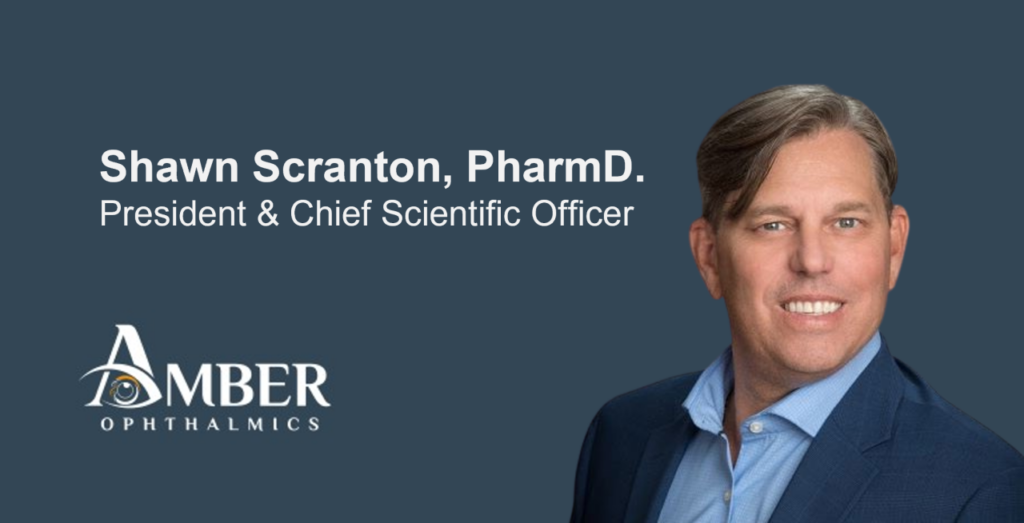Shawn Scranton, PharmD., on Revolutionizing the Treatment of Ophthalmic Diseases

We recently had the pleasure of sitting down with Shawn Scranton, PharmD., President and CSO at Amber Ophthalmics, a clinical-stage biotech company dedicated to addressing unmet treatment of ophthalmic diseases. Their groundbreaking work aims to restore, preserve, and improve the vision and quality of life of patients. We delve into their innovative drug, Nexagon® (lufepirsen ophthalmic gel), which shows great promise in transforming the standard of care for patients suffering from Persistent Corneal Epithelial Defect (PCED).
Please tell us about your company and the work your team is doing at Amber.
Ophthalmology is constantly on the cutting edge of medical innovation, and at Amber, we’re continuing to push the envelope. Our mission is to tackle unmet medical needs, resulting in the restoration, preservation, and improvement of patient vision and quality of life. Our work right now is focused on helping patients with PCED.
Can you describe the disease burden of PCED, please?
PCED, or Persistent Corneal Epithelial Defect, is a condition that poses significant challenges for affected individuals. The disease burden of PCED is substantial, with over 100,000 cases reported annually in the United States alone. PCED is characterized by a disruption in the corneal epithelium, the outermost layer of the cornea, which acts as a protective barrier for the underlying structures of the eye.
The condition manifests as a non-healing defect on the corneal surface, leading to persistent epithelial breakdown and impaired healing. This can result in severe pain, decreased visual acuity, and even a permanent loss of vision, all having a significant impact on the patient’s quality of life.
Unfortunately, there are currently no FDA-approved drugs specifically indicated for the treatment of PCED caused by various underlying causes. This creates a significant gap in effective treatment options for patients.
What prompted you to invest in the PCED disease area, and how do you expect your drug to affect patients in the future?
The lack of approved treatments for PCED represents a substantial unmet medical need. Witnessing the challenges faced by PCED patients motivated us to invest our resources and expertise in this area. Our innovative drug, Nexagon, is in clinical trials right now and has the potential to revolutionize the treatment of PCED and significantly improve patient outcomes. We envision Nexagon changing the treatment paradigm and offering effective relief to those suffering from PCED.
What is the current standard of care for PCED and what recourse do PCED patients have today?
Currently, the standard of care for PCED involves lubrication with preservative-free artificial tears and the use of bandage contact lenses. In cases where these measures are ineffective, patients may receive amniotic membrane or autologous serum drops, despite the fact that these treatments are not FDA approved. The need for more effective and FDA-approved treatments is substantial.
What’s unique about Nexagon, and how will it change the standard of care?
Nexagon is a first-in-class unmodified antisense oligonucleotide with a novel mechanism of action. It offers a unique benefit for PCED patients because it blocks connexin43 hemichannel formation, leading to restored corneal healing.
It can be conveniently administered topically in the physician’s office once a week for as few as four weeks. This reduces the burden on patients, who would otherwise need to self-administer drops multiple times a day for up to eight weeks. By streamlining the treatment process, Nexagon has the potential to greatly enhance patient compliance and convenience.
From your experience, what are some key learnings you have for other CEOs just starting their clinical trial journey?
For CEOs embarking on their clinical trial journey, we recommend carefully selecting a CRO that can be a product development partner, with a focus on treating the specific disease you are targeting. Additionally, ensure that they possess the required resources and scientific expertise to allocate to your study or program. This will help to maximize the chances of achieving successful outcomes.
Finding a partner who aligns with your values and has the necessary resources can significantly contribute to a successful collaboration, and ultimately a successful development program.
Thank you, Shawn!
Our Visionary Insights newsletter is published once a month and has thousands of subscribers. To stay in touch, subscribe today.
